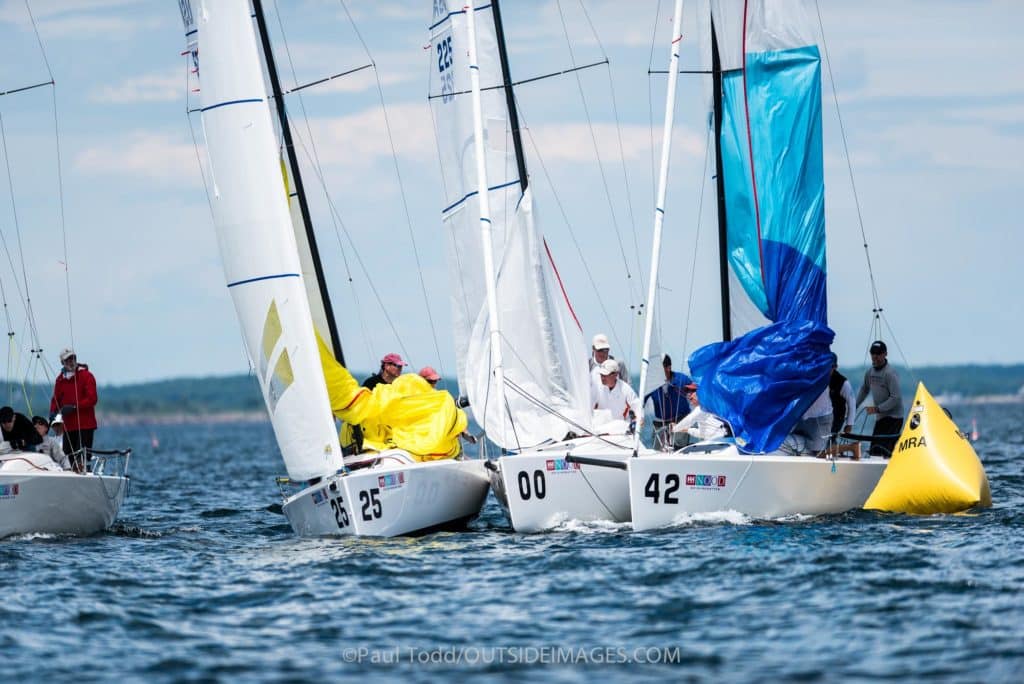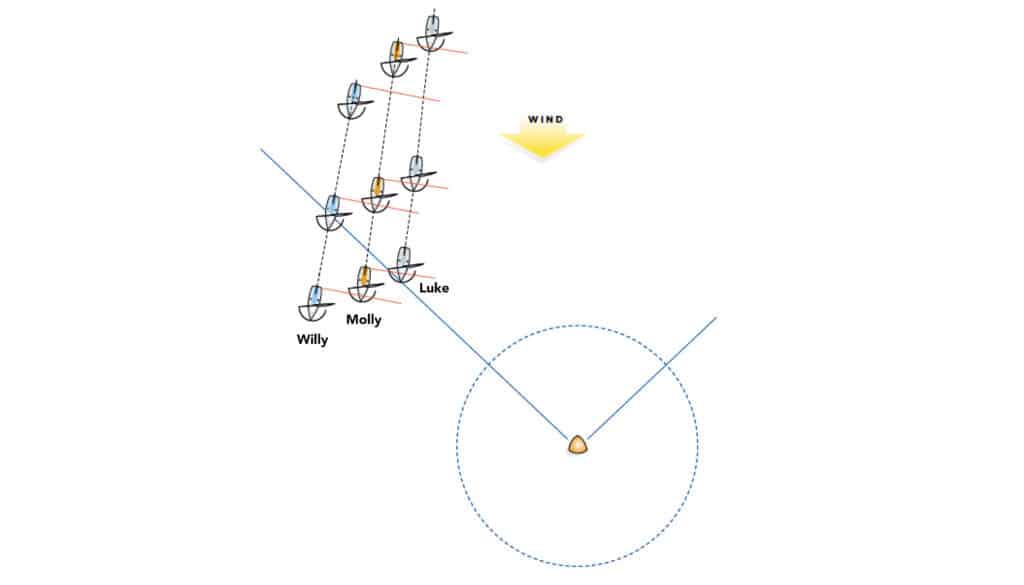
When you meet up with another boat in open water, well away from any marks or other boats, applying the rules is usually quite straightforward; the rules are written for pairs of boats. So when an incident involves two boats, you have to consider only the rules that apply for those two boats. But when there are three boats close to one another, things get more complex because you must consider the rules that apply for each pair of boats. For a three-boat incident, there are three pairs of boats; for a four-boat incident, there are six pairs.
Let’s consider what, at first glance, seems to be a very simple three-boat incident. The diagram shows Luke, Molly and Willie on starboard tack on a downwind leg. The boats are lightweight one-design boats, each sailing the course that maximizes its Velocity Made Good to the leeward mark. They are nearing the “jibe line” to the mark — if they sail past that line before jibing, as Willie and Molly do at Position 3, then their VMG to the mark will be slower than it would be if they jibe before reaching the line. The jibe lines on a run work like laylines on a beat to windward. If you sail past one of them, generally it will mean that you arrive at the mark later than a boat that sails to the mark without crossing one of them.
We’ll examine how the rules apply at each position shown. Because the boats are on the same tack, either Rule 11 or Rule 12 always applies to each of the three possible pairs of boats (Luke-Molly, Luke-Willie and Molly-Willie). The boats don’t change course during the incident, so Rule 16.1 does not apply. When right of way changes, Rule 15 must be considered. So far, so good. These rules are easy to apply, even though there are more pairs than in a two-boat incident. However, Rules 17 and 19.2(b), both of which must be considered for Luke, Molly and Willie, add more complexity.

At Position 1, Molly and Luke are overlapped, and each of them is clear astern of Willie. So, Rule 12 gives Willie right of way over Molly and Luke, and Rule 11 gives Luke right of way over Molly. I will assume that before Position 1, Luke was clear astern of Molly, and that when he became overlapped with her, the distance between their boats was less than two hull lengths. Therefore, Rule 17 applies, and it requires Luke not to sail above his proper course.
Willie has right of way over both Molly and Luke, so Willie is an obstruction to them (see the definition of “obstruction” in the rulebook). Molly is between Luke and Willie, and both Luke and Molly are sailing courses to pass to leeward of Willie. For these reasons, Rule 19.2(b) applies and requires Luke to give Molly room between him and Willie. Luke is not sailing above his proper course, and is sailing a course that allows Molly room to pass to leeward of Willie. So everyone is complying with all the applicable rules.
Let’s move on to Position 2. At this time, Molly and Luke have managed to gain on Willie, and an overlap begins between Molly and Willie. At that moment, several changes occur: (1) When Molly becomes overlapped with Willie, she is between Luke and Willie and overlapped with each of them. Thus, according to the definition of “overlap,” Luke also becomes overlapped with Willie. (2) Willie is then a windward boat to both Molly and Luke, so Rule 11 is “on,” Rule 12 is “off,” and Willie must now keep clear of both Molly and Luke.
(3) When Molly and Luke acquired right of way over Willie, Rule 15 applied. It applied “initially” — i.e., for only a few seconds, during which time it required both of them to give Willie room to fulfill his new obligation to keep clear of them. (4) The distances between Willie and Molly and between Willie and Luke are both less than two hull lengths, and therefore Rule 17 applies to both Molly and Luke with respect to Willie. It requires each of them to sail no higher than their proper course while they remain on starboard tack within two lengths of Willie and continue to have a leeward overlap on him.
(5) Finally, because it’s now Luke who has right of way over both Molly and Willie, Willie is no longer an obstruction, and Luke has become an obstruction to Molly and Willie. Rule 19.2(b) continues to apply, but now it requires Willie to give room to Molly to sail in the space between Willie and Luke.
OK, moving on again, consider Position 3. The relative positions of the boats have not changed. However, Luke has just reached the jibe line to the leeward mark. If Luke continues on starboard tack across the jibe line, he will break Rule 17. This is so because he will arrive at the leeward mark sooner if he jibes at Position 3 than he will if he continues to sail past the jibe line before jibing. Therefore, Luke’s proper course at Position 3 is to immediately bear off and jibe, and if he fails to do so and instead crosses the jibe line, he will be sailing above his proper course.
One might ask whether Molly also broke Rule 17, about a length before Position 3, when she sailed across the jibe line. The answer is no. The reasoning is as follows: At that time, Rule 17, as it applied to Molly and Willie, required Molly not to sail above her proper course, which was the course she would sail to finish as soon as possible in the absence of Willie. However, even if Willie were absent, Luke would still be present to leeward of Molly, and she would not have borne off and jibed into Luke’s path, as that would have caused her to break Rule 11 and then Rule 10. So, even after she crossed the jibe line, Molly’s proper course was not to bear off and jibe until Luke had done so. If Luke did bear off and jibe at Position 3, then Molly also would have been required to do the same immediately after Luke.
Finally, let’s change things a bit and assume Luke didn’t become overlapped to leeward of Molly while within two lengths of her. If that had happened, Rule 17 would not have applied to Luke and Molly at any time during the incident. Would that change how the rules apply at Positions 2 and 3? Again, the answer is no. Even though Rule 17 would not apply to Luke and Molly, it would still have applied to Molly and Willie and to Luke and Willie, because they were both within two lengths of Willie when they became overlapped to leeward of him. Therefore, the rules analysis above would still be the same at Positions 2 and 3.
If there had been four or more boats involved in this incident, the same set of rules would have been relevant, but there would have been twice as many pairs of boats to consider. What’s more, if a right-of-way boat had changed course during the incident, Rule 16.1 also would have applied, and if there had been contact between any boats, Rule 14 would have applied.
The complexity of four- and five-boat incidents shows why it is very important for race committees to set starting lines and courses so the chances of boats concentrating in a small patch of water are minimized in the first place.
Email for Dick Rose may be sent to rules@sailingworld.com.









